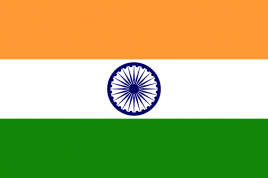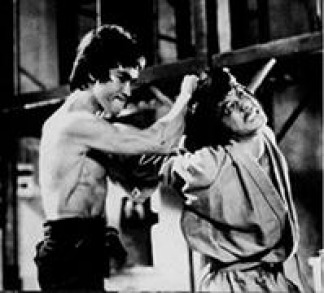BruceLee&Jackiechan
INDIA GEOGRAPHY,

india (Hindi: भारत Bhārat; see also other Indian languages), officially the Republic of India (Hindi: भारत गणराज्य Bhārat Gaṇarājya), is a country in South Asia. It is the seventh largest country by geographical area, the second most populous country, and the most populous democracy in the world. Bounded by the Indian Ocean on the south, the Arabian Sea on the west, and the Bay of Bengal on the east, India has a coastline of 7,517 kilometers (4,671 mi).[13] It borders Pakistan to the west;[14] China, Nepal, and Bhutan to the north-east; and Bangladesh and Myanmar (Burma) to the east. India is in the vicinity of Sri Lanka, the Maldives, and Indonesia in the Indian Ocean. Home to the Indus Valley Civilization and a region of historic trade routes and vast empires, the Indian subcontinent was identified with its commercial and cultural wealth for much of its long history.[15] Four major world religions, Hinduism, Buddhism, Jainism and Sikhism originated here, while Zoroastrianism, Judaism, Christianity and Islam arrived in the first millennium CE and shaped the region's diverse culture. Gradually annexed by the British East India Company from the early eighteenth century and colonised by the United Kingdom from the mid-nineteenth century, India became a modern nation state in 1947 after a struggle for independence that was marked by widespread nonviolent resistance.
India has the world's twelfth largest economy at market exchange rates and the fourth largest in purchasing power. Economic reforms have transformed it into the second fastest growing large economy;[16] however, it still suffers from high levels of poverty,[17] illiteracy, and malnutrition. A pluralistic, multilingual, and multiethnic society, India is also home to a diversity of wildlife in a variety of protected habitats.
CULTURE,
India's culture is marked by a high degree of syncretism[109] and cultural pluralism.[110] It has managed to preserve established traditions while absorbing new customs, traditions, and ideas from invaders and immigrants.
Indian architecture is one area that represents the diversity of Indian culture. Much of it, including notable monuments such as the Taj Mahal and other examples of Mughal architecture and South Indian architecture, comprises a blend of ancient and varied local traditions from several parts of the country and abroad. Vernacular architecture also displays notable regional variation.
Indian music covers a wide range of traditions and regional styles. Classical music largely encompasses the two genres - North Indian Hindustani, South Indian Carnatic traditions and their various offshoots in the form of regional folk music. Highly regionalised forms of popular music include filmi and folk music; the syncretic tradition of the bauls is a well-known form of the latter.
Indian dance too has diverse folk and classical forms. Among the well-known folk dances are the bhangra of the Punjab, the bihu of Assam, the chhau of Bihar and Orissa and the ghoomar of Rajasthan. Eight dance forms, many with narrative forms and mythological elements, have been accorded classical dance status by India's National Academy of Music, Dance, and Drama. These are: bharatanatyam of the state of Tamil Nadu, kathak of Uttar Pradesh, kathakali and mohiniyattam of Kerala, kuchipudi of Andhra Pradesh, manipuri of Manipur, odissi of the state of Orissa and the sattriya of Assam.[111]
Theatre in India often incorporates music, dance, and improvised or written dialogue.[112] Often based on Hindu mythology, but also borrowing from medieval romances, and news of social and political events, Indian theatre includes the bhavai of state of Gujarat, the jatra of West Bengal, the nautanki and ramlila of North India, the tamasha of Maharashtra, the terukkuttu of Tamil Nadu, and the yakshagana of Karnataka.[113]
A statue of Shiva, a principle deity of Hinduism, in Bangalore The Indian film industry is the largest in the world.[114] Bollywood, based in Mumbai, makes commercial Hindi films and is the most prolific film industry in the world.[115] Established traditions also exist in Bengali, Kannada, Malayalam, Marathi, Tamil, and Telugu language cinemas.[116]
The earliest works of Indian literature were transmitted orally and only later written down.[117] These included works of Sanskrit literature – such as the early Vedas, the epics Mahābhārata and Ramayana, the drama Abhijñānaśākuntalam (The Recognition of Śakuntalā), and poetry such as the Mahākāvya[118] – and the Tamil language Sangam literature.[119] Among Indian writers of the modern era active in Indian languages or English, Rabindranath Tagore won the Nobel Prize in 1913.
Indian cuisine is characterized by a wide variety of regional styles and sophisticated use of herbs and spices. The staple foods in the region are rice (especially in the south and the east) and wheat (predominantly in the north).[120] Spices originally native to the Indian subcontinent that are now consumed world wide include black pepper; in contrast, hot chili peppers, popular across India, were introduced by the Portuguese.[121]
Traditional Indian dress varies across the regions in its colours and styles and depends on various factors, including climate. Popular styles of dress include draped garments such as sari for women and dhoti or lungi for men; in addition, stitched clothes such as salwar kameez for women and kurta-pyjama and European-style trousers and shirts for men, are also popular.
Many Indian festivals are religious in origin, although several are celebrated irrespective of caste and creed. Some popular festivals are Diwali, Thai Pongal, Holi, Onam, Vijayadashami, Durga Puja, Eid ul-Fitr, Bakr-Id, Christmas, Buddha Jayanti and Vaisakhi.[122] India has three national holidays. Other sets of holidays, varying between nine and twelve, are officially observed in individual states. Religious practices are an integral part of everyday life and are a very public affair.
Traditional Indian family values are highly respected, although urban families now prefer the nuclear family structure due to the socio-economic constraints imposed by traditional joint family system.

